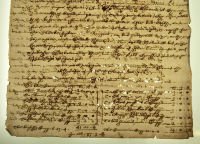Its corrosive effect on paper
 This 1623 abstract of a will (reference 1505/1/7) from our Farnham Council records shows typical corrosive damage by iron gall ink to paper, causing the letters to burn through the document. Iron gall ink was in use before the 7th century. A typical recipe for its manufacture required an infusion of crushed oak-galls (oak apples) in water. The extracted, naturally occurring gallic and tannic acids were then added to a solvent, either wine or vinegar, along with copperas (ferrous sulphate produced by roasting iron pyrites).
This 1623 abstract of a will (reference 1505/1/7) from our Farnham Council records shows typical corrosive damage by iron gall ink to paper, causing the letters to burn through the document. Iron gall ink was in use before the 7th century. A typical recipe for its manufacture required an infusion of crushed oak-galls (oak apples) in water. The extracted, naturally occurring gallic and tannic acids were then added to a solvent, either wine or vinegar, along with copperas (ferrous sulphate produced by roasting iron pyrites).
Earlier carbon inks - sometimes referred to as India inks - were prone to dampness and abrasion, and as a result likely to flake off the writing surface, especially from parchment. Alarmed medieval scholars realised an indelible ink was needed to prevent their work from vanishing.
It is only since 1945, that traditional iron gall inks have been officially replaced by dye-based inks, although a recipe listed as an official specification was still in use in Germany up until 1974.
The 'science'
Iron gall inks are fixed to the writing material by a chemical action, an acid compound; they do not need adhesives such as gum arabic. Over time oxidation occurs where the ink 'burns in' (the term for ink coming from the Latin 'encaustum' – 'burnt in'). Being insoluble in water, the ink cannot be washed away and is therefore 'permanent'. Sulphuric acid is formed as a by-product, eating away at the underlying paper. It can even migrate to adjacent sheets and attack them. Nevertheless, medieval recipes existed for erasing these acid based inks from parchment to recover the precious skins for writing!
The solution?
Research into iron gall ink corrosion continues and, as yet, there is no definitive solution. The preferred way to prolong the existence of originals written with iron gall ink is to store them in the appropriate environment, in particular in relative humidity under 60%, and also make sure they are handled carefully. In cases of advanced deterioration, where the document may soon resemble a paper doily, washing in an aqueous solution of calcium ammonium phytate followed by deacidification using aqueous calcium bicarbonate is a tried and tested method.
New treatments are being developed, among them splitting the paper and inserting a new stable core between the two layers, and electrolysis. In the meantime, while scientists pursue a solution, the age-old recommendations to keep documents in cool, dry (though not too dry) and dark conditions, with gentle handling, hold good.

